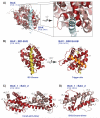The deadly landscape of pro-apoptotic BCL-2 proteins in the outer mitochondrial membrane
- PMID: 26662859
- PMCID: PMC4907887
- DOI: 10.1111/febs.13624
The deadly landscape of pro-apoptotic BCL-2 proteins in the outer mitochondrial membrane
Abstract
Apoptosis is a biological process that removes damaged, excess or infected cells through a genetically controlled mechanism. This process plays a crucial role in organismal development, immunity and tissue homeostasis, and alterations in apoptosis contribute to human diseases including cancer and auto-immunity. In the past two decades, significant efforts have focused on understanding the function of the BCL-2 proteins, a complex family of pro-survival and pro-apoptotic α-helical proteins that directly control the mitochondrial pathway of apoptosis. Diverse structural investigations of the BCL-2 family members have broadened our mechanistic understanding of their individual functions. However, an often over-looked aspect of the mitochondrial pathway of apoptosis is how the BCL-2 family specifically interacts with and targets the outer mitochondrial membrane to initiate apoptosis. Structural information on the relationship between the BCL-2 family and the outer mitochondrial membrane is missing; likewise, knowledge of the biophysical mechanisms by which the outer mitochondrial membrane affects and effects apoptosis is lacking. In this mini-review, we provide a current overview of the BCL-2 family members and discuss the latest structural insights into BAK/BAX activation and oligomerization in the context of the outer mitochondrial membrane and mitochondrial biology.
Keywords: BAK; BAX; BCL-2 family; MOMP; Structure; apoptosis; lipids; membrane; mitochondria; mitochondrial landscape.
© 2015 FEBS.
Figures



References
Publication types
MeSH terms
Substances
Grants and funding
LinkOut - more resources
Full Text Sources
Other Literature Sources
Research Materials
Miscellaneous

